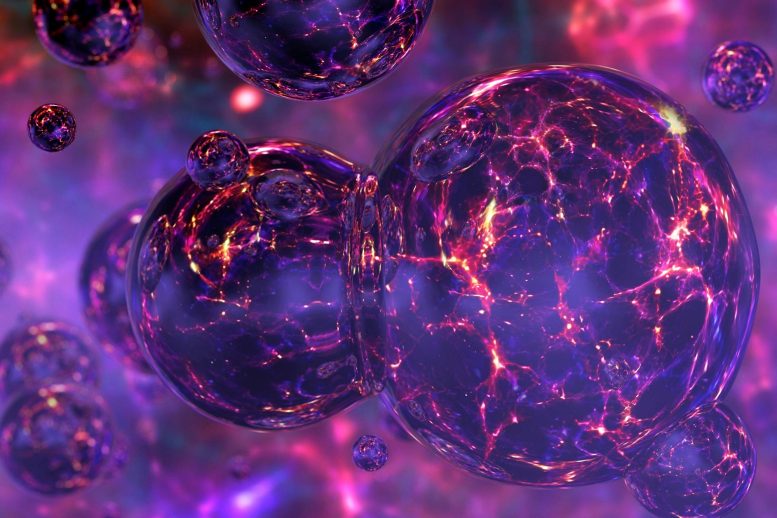
Is our universe on of many? Do universes pop up as bubbles from a multiverse?
It’s easy to envisage other universes, governed by slightly different laws of physics, in which no intelligent life, nor indeed any kind of organized complex systems, could arise. Should we, therefore, be surprised that a universe exists in which we were able to emerge?
That’s a question physicists including me have tried to answer for decades. But it is proving difficult. Although we can confidently trace cosmic history back to one second after the Big Bang, what happened before is harder to gauge. Our particle accelerators simply can’t produce enough energy to replicate the extreme conditions that prevailed in the first nanosecond.
But we expect that it’s in that first tiny fraction of a second that the key features of our universe were imprinted.
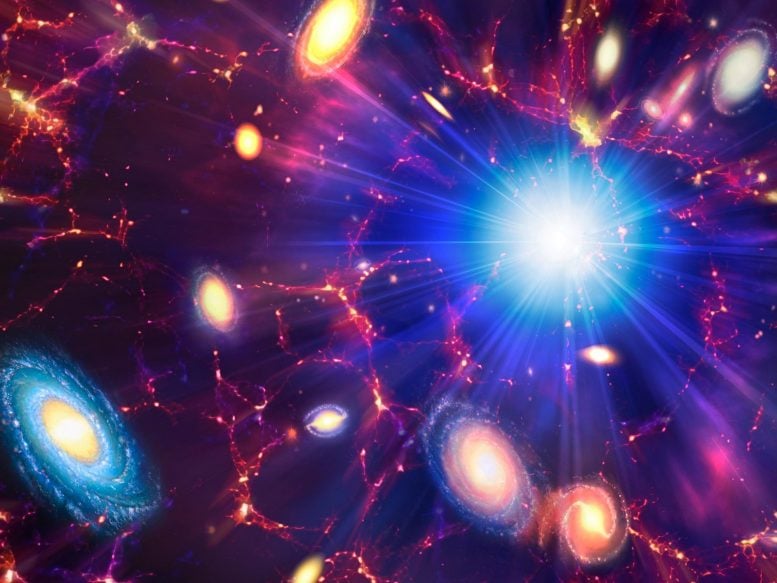
The Big Bang theory is the most widely accepted scientific explanation for the origins of the universe. It proposes that the universe began as a singularity, an infinitely dense and hot point that expanded rapidly about 13.8 billion years ago, and has been cooling and expanding ever since.
The conditions of the universe can be described through its “fundamental constants” – fixed quantities in nature, such as the gravitational constant (called G) or the speed of light (called C). There are about 30 of these representing the sizes and strengths of parameters such as particle masses, forces or the universe’s expansion. But our theories don’t explain what values these constants should have. Instead, we have to measure them and plug their values into our equations to accurately describe nature.
The values of the constants are in the range that allows complex systems such as stars, planets, carbon, and ultimately humans to evolve. Physicists have discovered that if we tweaked some of these parameters by just a few percent, it would render our universe lifeless. The fact that life exists therefore takes some explaining.
Some argue it is just a lucky coincidence. An alternative explanation, however, is that we live in a multiverse, containing domains with different physical laws and values of fundamental constants. Most might be wholly unsuitable for life. But a few should, statistically speaking, be life-friendly.
Impending revolution?
What is the extent of physical reality? We’re confident that it’s more extensive than the domain that astronomers can ever observe, even in principle. That domain is definitely finite. That’s essentially because, like on the ocean, there’s a horizon that we can’t see beyond. And just as we don’t think the ocean stops just beyond our horizon, we expect galaxies beyond the limit of our observable universe. In our accelerating universe, our remote descendants will also never be able to observe them.
Most physicists would agree there are galaxies that we can’t ever see, and that these outnumber the ones we can observe. If they stretched far enough, then everything we could ever imagine happening may be repeated over and over. Far beyond the horizon, we could all have avatars.
This vast (and mainly unobservable) domain would be the aftermath of “our” Big Bang – and would probably be governed by the same physical laws that prevail in the parts of the universe we can observe. But was our Big Bang the only one?
The theory of inflation, which suggests that the early universe underwent a period when it doubled in size every trillionth of a trillionth of a trillionth of a second has genuine observational support. It accounts for why the universe is so large and smooth, except for fluctuations and ripples that are the “seeds” for galaxy formation.
But physicists including Andrei Linde have shown that, under some specific but plausible assumptions about the uncertain physics at this ancient era, there would be an “eternal” production of Big Bangs – each giving rise to a new universe.
String theory, which is an attempt to unify gravity with the laws of microphysics, conjectures everything in the universe is made up of tiny, vibrating strings. But it makes the assumption that there are more dimensions than the ones we experience. These extra dimensions, it suggests, are compacted so tightly together that we don’t notice them all. And each type of compactification could create a universe with different microphysics – so other Big Bangs, when they cool down, could be governed by different laws.
The “laws of nature” may therefore, in this still grander perspective, be local by-laws governing our own cosmic patch.
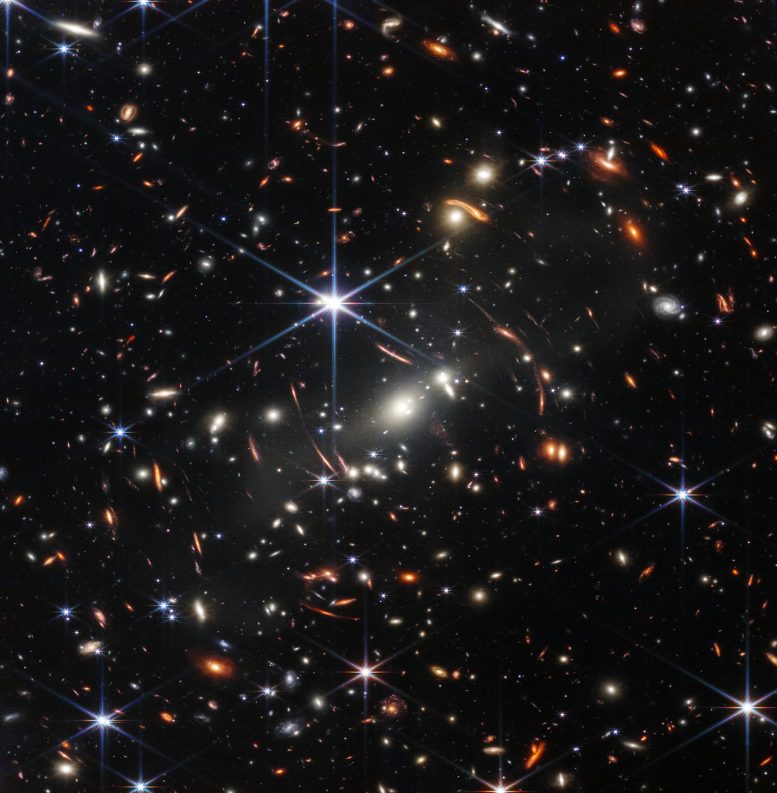
The NASA/ESA/CSA James Webb Space Telescope has produced the deepest and sharpest infrared image of the distant Universe to date. Known as Webb’s First Deep Field, this image of galaxy cluster SMACS 0723 is overflowing with detail. However, we can only see a fraction of the universe. Credit: NASA, ESA, CSA, and STScI
If physical reality is like this, then there’s a real motivation to explore “counterfactual” universes – places with different gravity, different physics, and so forth – to explore what range or parameters would allow complexity to emerge, and which would lead to sterile or “stillborn” cosmos. Excitingly, this is ongoing, with recent reseach suggesting you could imagine universes that are even more friendly to life than our own. Most “tweakings” of the physical constants, however, would render a universe stillborn.
That said, some don’t like the concept of the multiverse. They worry it would render the hope for a fundamental theory to explain the constants as vain as Kepler’s numerological quest to relate planetary orbits to nested platonic solids.
But our preferences are irrelevant to the way physical reality actually is – so we should surely be open-minded to the possibility of an imminent grand cosmological revolution. First we had the Copernican realization that the Earth wasn’t the center of the Solar System – it revolves around the Sun. Then we realized that there are zillions of planetary systems in our galaxy, and that there are zillions of galaxies in our observable universe.
So could it be that our observable domain – indeed our Big Bang – is a tiny part of a far larger and possibly diverse ensemble?
Physics or metaphysics?
How do we know just how atypical our universe is? To answer that we need to work out the probabilities of each combination of constants. And that’s a can of worms that we can’t yet open – it will have to await huge theoretical advances.
We don’t ultimately know if there are other Big Bangs. But they’re not just metaphysics. We might one day have reasons to believe that they exist.
Specifically, if we had a theory that described physics under the extreme conditions of the ultra-early Big Bang – and if that theory had been corroborated in other ways, for instance by deriving some unexplained parameters in the standard model of particle physics – then if it predicted multiple Big Bangs, we should take it seriously.
Critics sometimes argue that the multiverse is unscientific because we can’t ever observe other universes. But I disagree. We can’t observe the interior of black holes, but we believe what physicist Roger Penrose says about what happens there – his theory has gained credibility by agreeing with many things we can observe.
About 15 years ago, I was on a panel at Stanford where we were asked how seriously we took the multiverse concept – on the scale “would you bet your goldfish, your dog, or your life” on it. I said I was nearly at the dog level. Linde said he’d almost bet his life. Later, on being told this, physicist Steven Weinberg said he’d “happily bet Martin Rees’ dog and Andrei Linde’s life.”
Sadly, I suspect Linde, my dog and I will all be dead before we have an answer.
Indeed, we can’t even be sure we’d understand the answer – just as quantum theory is too difficult for monkeys. It’s conceivable that machine intelligence could explore the geometrical intricacies of some string theories and spew out, for instance, some generic features of the standard model. We’d then have confidence in the theory and take its other predictions seriously.
But we’d never have the “aha” insight moment that’s the greatest satisfaction for a theorist. Physical reality at its deepest level could be so profound that its elucidation would have to await posthuman species – depressing or exhilarating as that may be, according to taste. But it’s no reason to dismiss the multiverse as unscientific.
Written by Martin Rees, Emeritus Professor of Cosmology and Astrophysics, University of Cambridge.
This article was first published in The Conversation.![]()


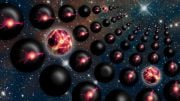




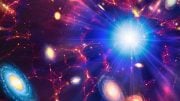
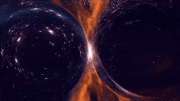
And there you have it! Reinterpreting the Multiverse to shore-up the Big “Everybody Knows This Is True” Bang Theory.
Maybe… Just maybe… One could engage Elon Musk to consider Multiverse Base One as a destination…
Hmm… We might already be there…
Perish the thought and pass the BUCK$!
British are forever working on making nature safe for young earth nutjobs while enabling free-ringing on the “inflation” and “recession” word-chimes, because they know all about “gravity.”
The thing that seems to make up the most compelling aspect of a good English colonial creation theory is it starts out about the size of a pea, bearing distinctive kink marks destined to expand as the mess grows.
More specifically it seems what happens is that after inflation fails to predict kink details just out of sight a sufficient number of times, it becomes an eccentricity of the details of the universe, not merely yet another failure of cosmological inflation theory. This certitude apparently stems from scientific luminary history with the uncanny coincidence of a Russian submitting the same inflation idea around the same time as someone from NYC, especially as a cold war was supposedly going on. I mean what conspiracy could better spook people into adopting inflation theory than that? Nothing.
I wouldn’t want to suggest the universe isn’t “expanding” around us without offering support for such a difficult perspective. Fact is it’s not just a fantastical super-rapid inflation theory contributing to the confusion, but more clearly there’s a dubious consensus theory of gravity being pushed way too hard by a biased media with a bad track record.
ASTUTE SUMMATION… 👍
For whatever it’s worth, I imagine the “true vacuum” is a useful concept even though nothing like it has never been created.
That’s where I decided to go completely unsupported to suppose a false vacuum carries self-cohering resolution-limited electromagnetic energy. Rather than supposing a true vacuum would be catastrophic, I suppose the positive energy of a false vacuum inevitably divides and covers any available true vacuum, ultimately surrounding Planck-scaled volumes of “negative energy” that I suppose are at the core of every quantum of gravity, creating an vacuum energy dipole composite particle with a field vector carrier effect.
I suppose one might be able to say negative energy itself has no speed limit and this may support some visualization of a negative-energy-leading dipole as the field carrier, setting the initial vector direction of the gravity carrier.
Adding cold-matter-based focus and intrinsic galactic-scale rotational momentum to such quanta appears sufficient to explain dark sector physics in full.
Thank you for your interest.
To my knowledge, no one to date has found any of the extra dimensions. Some universes also are thought to be near enough to leave evidence of “bruising” to our own universe but that hasn’t been seen either.
Meanwhile, I agree that a theory that doesn’t make testable predictions is greatly flawed. Sting Theory, despite its “beautiful math” is descending.
And the same with so-called “dark energy/matter”?
In an infinite void you can accommodate an infinite number of universes without them interfering with each other. Simples.
The existence of matter — or energy if you prefer, as they are the same (e=mc2) — defies any explanation.
One thing is certain, an explanation for the existence of matter does exist. But the probabilities that we humans will someday find it are next to zero, not to say zero. Because it defies any logic, as you cannot possibly have nothing and all the sudden have something come out of that nothing on its own.
There is nothing other than what we make for ourselves. The human species will survive itself only if it faces that hard reality, not to say that horrific reality.
It’s always interesting to read that our preferences are irrelevant when this entire article neglects to mention the most logical answer because of the preferences of the author. Design. Science today has become a religion with its priesthood calling themselves “scientists” and they will conjecture and model anything as long as it gives a mechanistic that allows them to ignore the elephant in the room.
How does this speculation differ from science fantasy? Where is the falsifiable hypothesis that is the basis of science? How can parallel universes be perceived, let alone observed and measured? It seems to me that even if parallel universes exist, but there is no way to verify them, it is a moot point. One might as well speculate about unicorns or multiple gods. It is a fruitless exercise.
I don’t mind funding theoretical speculation in many fields — greenhouse warming being a case in point. However, considering the need to clean up our own nest before disasters that we haven’t theoretically predicted become real, I would strongly advise this sort of thing being put on the backburners with no funding allowed. It isn’t basic research, in my opinion, but fun and games that should be done after hours (and sometimes in bootlegged experiments within real-world experiments.) Later, in another century or two, when we get the planet out of our mess, we can look at this again.
There’s a low-class british physics site google likes too much that favors a slimy overdone gimmick where general relativity troll characters inevitably pre-emptively dump abuse aimed at any and all dark matter cynicism. Of course they’re just losers carrying equity in Einstein’s gravity.
There is so much focus on the initial seconds of the creation of our universe but I would like some explanation as to how/what created the underlying particles and laws that control the operation of this universe?
An explosion could not create the myriad particles and physical laws of our universe with the snap of a finger any more than an explosion can create say, a fully working city.
What determined the need for all the various sub-atomic particles that exist, how they interact, what would result from each interaction, etc.?
The only reasonable explanation is that these particles/laws were created somewhere else and therefore, our universe must be a pimple/zit on the surface of the multiverse that exploded outward. If this is true, then it means that every possible universe would have the same set of particles and physical laws.
Now, how do we get into either the mother metaverse or another child universe?
… the dark energy, just hope that Americanos and Russians don’t kill of the planet… that is what happens when Britain doesn’t resist and Greta Thunberg’s favorite president protects the nature,… a Biden way to go…